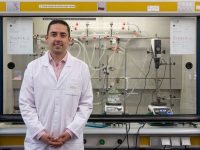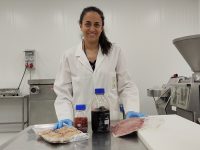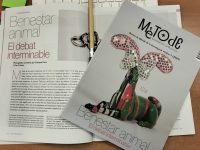 © CSIC Some of the scientists in the game Plants in our lives. From left to right: Johann Wolfgang von Goethe, Matthias Jakob Schleiden, Gregor Mendel, Charles Darwin, Martinus Willem Beijerinck and Norman Borlaug. |
||
|
Plants are organisms capable of capturing light energy and transform it into chemical energy, contained in the sugars that are incorporated to their biomass. It is an essential link in the trophic chain which allows the sustenance of animals, and therefore, of human beings. When they make photosynthesis, these incorporate carbon dioxide from the atmosphere and release the oxygen we breathe. It is estimated that plants, together with algae and cyan bacteria, incorporate around 100 billion tons of carbon dioxide per year, reason for which the play an essential role on the regulation of greenhouse gas levels. We can say that, in an individual scale and in a global scale, life would not be possible without plants. This is why form EPSO (European Plant Science Organization) we want to encourage you to celebrate the International Fascination of Plants Day on the 18th of May of 2012. For the occasion we have prepared a game —Plants in our life— distributed together with this issue of Mètode, which revolves around plants and scientists and their discoveries. It is not strange, then, that plants have provoked such an irresistible attraction for scientific research. Goethe published in 1790 The Metamorphosis of Plants, where he gave an account of his naturalistic observations, which led him to make the hypothesis that leaves and floral organs were evidence of a common design. Two hundred years later, reverse genetics techniques have made possible to prove that, when the activity of three types of genes are repressed in flowers, all of the floral organs (sepals, petals, stamen and carpels) become leaves. Goethe was right. FROM GENETICS TO VIROLOGY On the 19th century two great figures of science felt the same fascination for plants. Gregor Mendel discovered the main laws of biological inheritance and the concept of informative units that are passed on to children from their parents— genes. Genetics had been born. At the same time, Darwin, ignoring Mendel’s discoveries, proposed the theory of evolution of species by natural selection, even though he didn’t know the mechanisms through which random variations where inherited. However, Darwin studied meticulously the capacity of plants to make movements to allow them to use stems, branches, peduncles, petioles, tendrils or adventitious roots in order to improve their exposure to light. He also observed the movement of carnivorous plants, which allow them to make oscillatory movements or to bend depending on environmental factors, like light. Mathias Schleiden proposed the cell theory according to which the cell is the structural unit common to all plants, and observed that they grow by generating new cells. Roger Gautheret and Philip White discovered, in the mid 20th century, the way to grow plants in vitro adding Indole-3-acetic acid, the auxin discovered by Frits Wentel in culture media, and taking advantage of the surprising capacity (totipotency) plant cells have to become any kind of cell and therefore create a new plant. After that, Eiichi Kurosawa discovered gibberellins, which regulate the growth of stems, and other plant growth controllers. In vitro culture techniques and clonal production of plants brought about Jeff Schnell’s and Marc van Montagu’s discovery of the genetic transfer mechanism between plants and Agrobacterium, which is used today as an instrument for reverse genetics techniques, from the gene isolated in the laboratory to the introduction of it in a plant. These techniques provide a formidable strength to the challenge of understanding the function of genes, and at the same time they have been useful for generating transgenic harvests— more than 148 million hectares of these crops were planted in 2010. In order to be efficient, these techniques needed an appropriate experimental system based on a model plant. The scientific community found appropriate an herbaceous plant from the brassicaceae family, Arabidopsis thaliana, with a relatively small genome, the complete sequence of which is known since the year 2000. It is a diploid species with a great natural variability, its generation time is short, it produces a high number of seeds per plant and is easily genetically modified in planta. This experimental system has allowed us to find the genetic and molecular bases which underlie the properties of plants, like, for instance, their capacity to bend towards light, observed by Darwin. According to FAO (Food and Agriculture Organization), food security will be accomplished when all the people are able to access, at any moment, both physically and economically, enough and safe food, and that meet their nutritional requirements in order to live an active and healthy life. This objective is far from being achieved in spite of the Green Revolution that meant Norman Borlaug’s development of very productive varieties of rice and wheat thanks to their short growing cycle and reduced size, which diminish losses due to the overturning of the spikes of these gramineae. Still today, around one billion people of the seven billion in the world live in hunger or are badly fed. On the other hand, modern agricultural practices use a great deal of natural resources, like water and the Sun, and also energetic resources in order to work the lands and produce the fertilizers needed. The challenge for the future is to produce more (it is estimated that the population will go on growing during the 21st century exceeding ten billion inhabitants) and use less resources, thus reducing pollution. Thanks to genetic engineering based on reverse genetics we have been able to find, for instance, that the genes that make Borlaug’s spikes to be so short are the ones that have to do with the response of the stems to gibberellins. This is the reason why we can immediately develop new varieties in other plants with this characteristic of agricultural interest. Will we arrive on time in the process of getting to know plants in order to contribute to achieve FAO’s goal of its food security programme? As in the case of genetics, there is another scientific discipline that benefited from the study of plants for its development. It is the case of virology. Martinus Beijerinck showed for the first time that the agent causing the tobacco mosaic disease (TMV) was a new kind and named it virus. Beijerinck also discovered, working with Vicia faba, the principle of symbiotic nitrogen fixation for legumes; an essential process to keep the lands fertile. The understanding of the molecular bases of atmospheric nitrogen fixation is a research priority nowadays, since strategies could be made based on genetic engineering in order to transfer this capacity to essential species for nutrition, like gramineae. WHAT IS LEFT TO DISCOVER IN PLANTS? We have seen that plants are fascinating organisms. They are so by themselves, because of how they are and what are capable of doing; and they are for humankind because without them we wouldn’t exist. Well, it is the 21st century and we still don’t know many things about plants. For starters, we know only a part of the 250.000 species of plants that are estimated to live on Earth. In fact, with a lot of effort we use only a handful of species in order to feed ourselves and, among these, we reduce continually their diversity. Regarding wild plants, there is still a lot to know as well. We notice there is an accelerated loss of biodiversity strengthened by anthropological activities. This way, we are losing thousands of new metabolites assimilated by plants with activities that can be useful to fight diseases or understanding how plants relate to each other and to animals. We have to move from studying plants one by one to understand their role in the ecological networks. We have just started to discover the architecture of biodiversity! Darwin described mutualistic relationships, from species to species, studying the reproduction of orchids; however, today we start to know that mutualistic networks involve tens or hundreds of species. That is why we are developing new disciplines like systems biology. From a reductionist point of view, our impressive technical capacity for sequencing genomes, isolate genes and discovering their functions have only allowed us to envision the scope of nutrigenomics (the study of the way in which the food we eat modify the expression of our genes) and nutrigenetics (the study of genetic variations among individuals in the interaction between diet and disease) which will allow in the future to design personalised diets according to the genetics of the individual. Stephen Hawking has recently stated that he does not think that the human race will survive another thousand years not leaving Earth, and advises to look to the stars and not to our feet. I humbly think that it is worth giving another chance to our life on Earth. This is why it is necessary to intensify our knowledge of plants, from their role in ecosystems to their wonderful capacities hoarded all along biological evolution. |
«Plants are an essential link in the trophic chain which allows the sustenance of animals, and therefore, of human beings»
«It is necessary to intensify our knowledge of plants, from their role in ecosystems to their wonderful capacities hoarded all along biological evolution»
«For the International Fascination of Plants Day we have prepared a game distributed together with this issue of Mètode» |
|
Search
© Mètode 2012 - 73. Online only. The Strength of the World - Spring 2012
José Pío Beltrán
Research Professor at the Institute for Plant Molecular and Cellular Biology (IBMCP, CSIC-UPV) in Valencia (Spain). Director of the Laboratory of Biology and Biotechnology of Reproductive Development. Founder of Casa de la Ciència in Valencia. He was President of the European Plant Science Organization and the European Federation of Plant Biology Societies.







